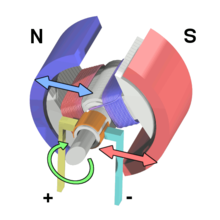Ørsted's discovery in 1821 that a magnetic field existed around all sides of a wire carrying an electric current indicated that there was a direct relationship between electricity and magnetism. Moreover, the interaction seemed different from gravitational and electrostatic forces, the two forces of nature then known. The force on the compass needle did not direct it to or away from the current-carrying wire, but acted at right angles to it.[29] Ørsted's slightly obscure words were that "the electric conflict acts in a revolving manner." The force also depended on the direction of the current, for if the flow was reversed, then the force did too.[44]
Ørsted did not fully understand his discovery, but he observed the effect was reciprocal: a current exerts a force on a magnet, and a magnetic field exerts a force on a current. The phenomenon was further investigated by Ampère, who discovered that two parallel current-carrying wires exerted a force upon each other: two wires conducting currents in the same direction are attracted to each other, while wires containing currents in opposite directions are forced apart.[45] The interaction is mediated by the magnetic field each current produces and forms the basis for the international definition of the ampere.[45]

This relationship between magnetic fields and currents is extremely important, for it led to Michael Faraday's invention of the electric motor in 1821. Faraday's homopolar motor consisted of a permanent magnet sitting in a pool of mercury. A current was allowed through a wire suspended from a pivot above the magnet and dipped into the mercury. The magnet exerted a tangential force on the wire, making it circle around the magnet for as long as the current was maintained.[46]
Experimentation by Faraday in 1831 revealed that a wire moving perpendicular to a magnetic field developed a potential difference between its ends. Further analysis of this process, known as electromagnetic induction, enabled him to state the principle, now known as Faraday's law of induction, that the potential difference induced in a closed circuit is proportional to the rate of change of magnetic flux through the loop. Exploitation of this discovery enabled him to invent the first electrical generator in 1831, in which he converted the mechanical energy of a rotating copper disc to electrical energy.[46] Faraday's disc was inefficient and of no use as a practical generator, but it showed the possibility of generating electric power using magnetism, a possibility that would be taken up by those that followed on from his work.
Faraday's and Ampère's work showed that a time-varying magnetic field acted as a source of an electric field, and a time-varying electric field was a source of a magnetic field. Thus, when either field is changing in time, then a field of the other is necessarily induced.[47] Such a phenomenon has the properties of a wave, and is naturally referred to as an electromagnetic wave. Electromagnetic waves were analysed theoretically by James Clerk Maxwell in 1864. Maxwell developed a set of equations that could unambiguously describe the interrelationship between electric field, magnetic field, electric charge, and electric current. He could moreover prove that such a wave would necessarily travel at the speed of light, and thus light itself was a form of electromagnetic radiation. Maxwell's Laws, which unify light, fields, and charge are one of the great milestones of theoretical physics.[4


0 comments:
Post a Comment